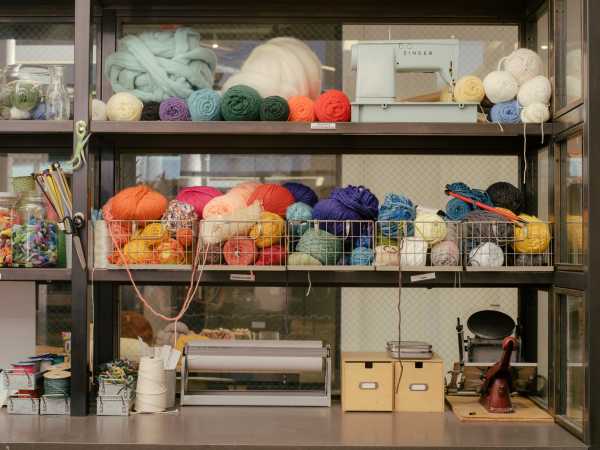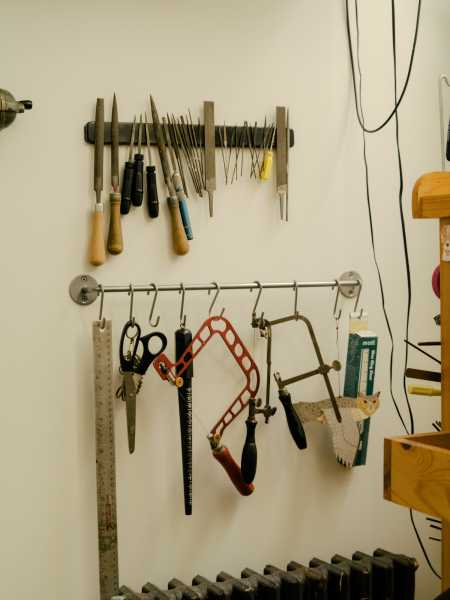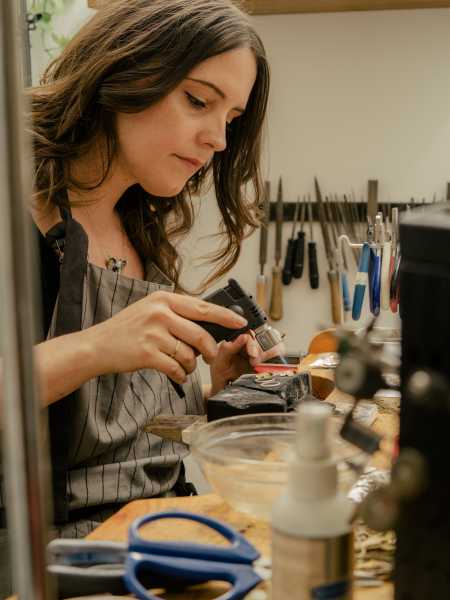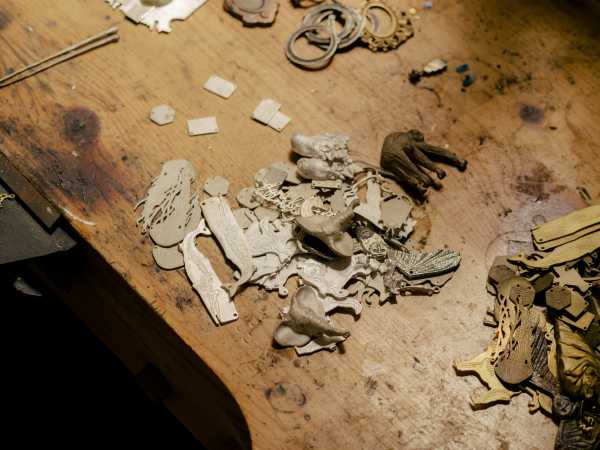
Share this story
-
Share this on Facebook
-
Share this on Twitter
-
Share
All sharing options
Share
All sharing options for:
Was Etsy too good to be true?
-
Twitter
-
Facebook
-
Reddit
-
Pocket
-
Flipboard
-
Email
This story is part of a group of stories called

As a stockholder, Jeni Sandberg loves Etsy. As a vintage homegoods purveyor selling midcentury glassware and linens on Etsy’s platform, she can’t help but feel like she’s being played.
In July, the company announced it would be encouraging sellers to offer free US shipping on all orders over $35. Or rather, it announced that sellers who didn’t offer free shipping would be de-prioritized by the site’s highly competitive search algorithm, which — on a platform with more than 60 million things to buy — can be the difference between regular sales and functional invisibility.
There was a good argument for the new policy on the company’s end: Right now, customers add things to their cart and balk at shipping costs, then bounce from the site for good. We, as a consuming public, do not like to be forced to reconsider. We don’t stand for being disappointed even for a moment. We are, frankly, skittish. And people who make lightweight products — jewelry, pins, embroideries, T-shirts — can afford to eat a couple of dollars in shipping cost if it’s going to boost their sales overall.
But can a furniture maker? Can a woman who makes ceramic planters shaped like Frida Kahlo? Can a man who sells (heavy!) replicas of human skulls? The directive from the company has been to staple the cost of shipping onto the item’s price, which sellers have pointed out is not actually free shipping. It doesn’t help that Etsy changed its transaction fee from 3.5 percent to 5 percent last June — fair enough, it had been flat for 13 years, but still, the timing. Back-to-back summers!
“I’m like yeah, damn straight. Make everybody get free shipping,” Sandberg says, as a stockholder. “Believe me, I can’t wait for fourth-quarter earnings reports. It’s going to look like their gross sales skyrocketed. It’s going to look awesome on paper.” Then she adds, as a vintage homegoods purveyor, “But they’re screwing sellers to get there.”

When Etsy went public in 2015, it offered a participation program that let Etsy sellers buy stock before the offering. Sandberg bought $2,500 worth then, and she bought more right after the IPO, and she bought even more after Etsy announced its free shipping push. The cognitive dissonance she experiences every time Etsy announces a move that wrings additional revenue out of its sellers is the product of a tension that isn’t exactly Etsy’s fault. Have you heard of Amazon? In 2005, four months before Etsy launched, Amazon decided that everyone wanted things delivered fast and for free, and announced a service called Amazon Prime. Now, after a while of getting things delivered fast and for free, we agree this is something we need, the same way we agreed we needed phones that could access the internet or televisions that could record football games we missed or highways that could connect major cities.
What choice does Etsy have but to try to thrive in the new normal? It’s advertising on television now, gearing up for a marketing push around free shipping in mid-September, and implying to sellers that all of their financial concerns will vanish once Etsy is a true household name.
“Why would you expect free shipping from the nice lady in Iowa who hand-knits afghans? Why would you think that she would be able to do that for you?” Sandberg asks, hypothetically, of the customers Etsy says it has polled in robust surveys over the past few years. “If I were sending something to her, it would cost me $12. I understand that. I’m a grown-up.”
The lady hand-making afghans in Iowa has enough working against her, you know? Plus, as Sandberg explains, channeling the sentiment of Etsy’s 2 million sellers: “Etsy was supposed to be different.”
Etsy was founded in 2005 by Rob Kalin, a construction worker and bookseller in New York City looking for a way to sell handmade furniture on the internet. Most of his friends were looking for a way to sell handmade things too. None of his friends knew how to make an online shop, but he did. It was clear: He should make one shop for all of them and set them up to be, as he often says, “the protagonists of their own lives.”
The timing was perfect. E-commerce was just getting off the ground; Martha Stewart was getting out of prison! Women were running enormously popular and newly lucrative personal websites, where they posted their DIY projects and wrote about the value of their labor. “The new crafter wave is fueled by an intriguing alliance of the oldest and newest of social technologies, the sewing circle and the blog,” craft historian Glenn Adamson wrote shortly after. “In a sense, the 21st century of craft is beginning the way that the 20th did: by finding in tradition the possibility for social change.”
The timing was perfect. E-commerce was just getting off the ground; Martha Stewart was getting out of prison!
The mid-aughts conception of Etsy was heavily informed by Kalin’s friendship with New York University professor Jean Railla, creator of the early online crafting community Get Crafty, who wrote often about the handmade as an act of resistance against capitalism and patriarchy. Kalin’s vision for Etsy, as he told the Wall Street Journal in 2010, just 16 months before he would be ousted from his own company, is this: “Instead of having an economy dictate the behavior of communities, to empower communities to influence the behavior of economies.”
Crafters have tried to take down mass production before. The Arts and Crafts movement that took place in England and the United States in the late 19th and early 20th centuries was a reaction to the Industrial Revolution. There was a boom in DIY-ism in the US after World War II, jump-started by the founding of the American Craft Council in 1943 and the sprawl of the suburbs, where there were always home projects to be done — a backlash, once again, against assembly-line goods and the American dream’s emphasis on cookie-cutter conformity. Feminists manipulated crafts to make various statements about gender and power from the 1970s all the way up through the riot grrrl movement in the 1990s, and continuing even now, with, most famously, thousands and thousands of (controversial) hand-knitted “pussy” hats.
But dreams of unmaking, by hand, what the Romanticist scholar and furniture designer William Morris called “the terrible organization of competitive commerce,” have historically been only that: dreams.
In the beginning, by all accounts, Etsy was the epicenter of the internet-age craft movement and its attendant community. About 90 percent of the early sellers were women — today it’s still 87 percent — and they were all making certifiably handmade objects: paintings, sweaters, porcelain bowls. Also, infamously, crocheted tampon holders. The buyers were other people like them. The company’s employees were people like them too.
The site’s first in-house counsel Sarah Feingold started selling jewelry on Etsy after graduating from law school, then bought herself a JetBlue ticket and explained to Kalin that his company needed at least one lawyer. The earliest Etsy office rented out spare desks to the editors of Make Magazine and a soon-to-be creator of the 3D-printing company MakerBot, as well as the co-founders of sewing community site BurdaStyle, Benedikta Karaisl and Nora Abousteit. Hanging out in the first Etsy offices, in a beat-up building in downtown Brooklyn, Kalin taught Karaisl and Abousteit how to use Adobe Illustrator, helping make the wireframes for the first version of their site.

Abousteit got a front-row seat to how things worked in Etsy’s earliest days. “There was this one woman who [worked there] who used to wake up every two hours just to curate the Etsy homepage,” she remembers. “It was really a passion. It was amazing. I mean, there wasn’t that much going on in the tech scene in New York, and also the whole craft-making scene was just starting, just budding.”
Soon after Etsy’s founding, the company started Street Teams: coalitions of crafters who could organize to get better treatment and fairer rent when they wanted to participate in art fairs or set up pop-ups. Kalin had plans to open “co-production” sites across the country, and he hosted public craft nights in the Etsy headquarters every Monday. In the New York Times, journalist and artist Rob Walker observed the early Etsy scene, writing, “This is not a utopian alt-youth framework; it’s a very real-world, alt-grown-up framework.” It was a gorgeous and daunting one, with the odds quite obviously stacked against it.
The press did not know what to do with Kalin, or with Etsy. Who would take Silicon Valley’s optimism to such a twisted extreme by excising the get-rich stuff that made it so sexy? Every reporter who wrote about Kalin paused for a moment to note that he made his own underwear.
Etsy grew quickly, but with strings. The New York venture capital firm Union Square Ventures put up a small amount of money in the summer of 2006, a year before it invested in Twitter. By 2008, venture capitalist Jim Breyer — a board member at Facebook and Walmart — was leading a $27 million funding round. Suddenly, a better life for crafters could not be the company’s only goal. It also had to make serious money for some people who are pretty serious about their money.
In a fit of twisted luck, that same year saw the start of a global recession that made the case for Etsy obvious. It was a moment when people were reluctant to spend money but expressed some desire to spend it in venues where it seemed as though it might directly benefit another person, and Etsy sold $10.8 million worth of goods in November 2008, up from $4.2 million in November 2007. The company was profitable for the first time the next year, and transactions doubled again between 2008 and 2009.
In a fit of twisted luck, that same year saw the start of a global recession that made the case for Etsy obvious
But the growth — and yet another round of VC funding — put even more pressure on Etsy. Chief technology officer Chad Dickerson had taken over as CEO after Kalin was voted out by the board in July 2011, and in October 2013, in an infamous town hall meeting at Etsy HQ, he announced that the company would allow sellers to contract with outside manufacturers to help make their products, so long as they designed everything themselves and were willing to provide detailed explanations of their process to Etsy’s Marketplace Integrity team.
Much of the community was aghast, fearing the change would ruin the culture of the site forever. But the decision was necessary; popular sellers were turning themselves into one-person factories, working 90 hours a week to make enough to keep up with demand and turn even a modest profit. It was silly not to be allowed to collaborate. It didn’t make sense to define “handmade” as “made from scratch by one person”; almost everybody has to use some kind of machine or buy supplies or incorporate something that didn’t go straight from the earth to their hands at one point or another. Litigating “handmade” wouldn’t be very modern. In itself, it seemed against the spirit of Etsy.
“I think the question of Etsy losing its way or abandoning its values is one that’s been reported five years ago, seven years ago, at many different points in time,” says Alison Feldmann, one of the company’s first employees, who started as an intern in 2007 and left the company in November 2017 as the director of brand and content. When she started, she was elated to be in the mix — filling the office with used desks from Craigslist, taking out the trash, saving the world. “As a progressive business, people are going to be taking potshots at any change that happens in terms of ‘selling out.’ You know, it isn’t a nonprofit. It is a capitalist world that we live in.”
Vania Scharbach opened her first Etsy store in 2007, soon after immigrating to Brooklyn from Brazil, where she sold handmade clothes in a brick-and-mortar storefront. At the time, she says, it was “so cool, the hipster eBay.”
Now it’s different: “I understand they’re a corporation and they need to make a profit, okay, but the thing is they went away from what they were, from the goals of the website.” A lot of the vintage clothing she sees is junk; a lot of the print-on-demand products are just a basic design that a third-party company slaps on a product and drop-ships to the customer.


“If I go buy 100 percent linen at a store in Manhattan and make a dress myself and list it on Etsy, I can’t sell that for less than $150,” Scharbach says. “Then when you’re shopping, you see these other listings for like $50, the same type of dress, it looks like the same quality. You buy it and you realize it’s not really linen, it’s made by a person but it’s made in a sweatshop somewhere. It’s hard to compete.”
Etsy refutes these kinds of concerns. “Our policies haven’t changed. You either have to be the person who made the product or the person who designed the product with a direct relationship with the people making it, or it has to be vintage and over 20 years old,” Etsy’s current CEO Josh Silverman says, asked about seller complaints that mass-produced, imported junk or boring, basically identical bridesmaid-font products are taking over the site. “If you look at the composition of products on the site, it’s the same. There is not an increase in products from bigger sellers.”
But I am looking at the site. When I typed “scarf” into Etsy, the first page of results included $6 pashminas and “custom satin edge scarves” with “Your Logo Here” photoshopped onto them ($9.99), and very few “handmade” listings that are priced anywhere near what an actual handmade scarf costs.
To me, this doesn’t read as “Etsy.” But to Etsy, in 2019, it does.
There are competing opinions about when exactly Etsy took the turn that would lead it here, but most agree that the company’s IPO was one of the stops along the way. The company had taken in a total of $97.3 million in venture money by the time it went public in 2015, and Etsy’s IPO was a big deal, imbued with surreal significance; The New York Times called it “an experiment in corporate governance, a test of whether Wall Street will embrace a company that puts doing social and environmental good on the same pedestal with, if not ahead of, maximizing profits.” But Wall Street did not embrace Etsy. Within two months, share prices dropped to about 50 percent of where they’d been when trading opened. Initially a smash hit, it soured quickly into one of the worst IPOs of the year.
“Handmade is not the value proposition — unique, personalized, expresses your sense of identity, those are things that speak to buyers”
Silverman, a former president of consumer products and services at American Express, former CEO of Skype, former CEO of eBay’s Shopping.com, co-founder of Evite, and so on, came in about two years later to put out what investors openly referred to as a fire. (“The house was burning and nobody was paying attention,” Etsy board member and Union Square Ventures co-founder Fred Wilson told the New York Times.)
Private equity firms and hedge funds were swarming around Etsy, buying up shares and giving off serious potential-hostile-takeover vibes, suggesting to the board that the company wasn’t growing fast enough, that it wasn’t focusing on profit, and that it was overspending. It wasn’t even making very smart technical operations decisions at the time, insisting on running its own servers rather than contracting with Google Cloud or Amazon Web Services. So the company fired 80 people, including Dickerson (who declined to comment for this article), and Silverman took over. Within two months he fired 140 more. He shut down major projects including Etsy Studio, a separate online store for craft supplies than had been live for less than a year.
Silverman doesn’t like the words “handmade” or “craft” because they “don’t communicate anything to buyers about when to think of Etsy.” he says now. Nobody wakes up thinking, “Gosh, I need to buy something handmade today,” he tells me, which may be true but I rarely wake up thinking I need to buy anything at all, and more commonly wake up in horror because I’ve already bought way too much.
“You need to furnish your apartment. You need to prepare for a party. You need to find a gift for a friend. You need a dress. Handmade is not the value proposition — unique, personalized, expresses your sense of identity, those are things that speak to buyers.”
Handmade is not the value proposition!
Three months before Rob Kalin was forced out of Etsy, Inc magazine ran a cover story about him, which ended up as an interrogation of whether he was fit to be the company’s CEO. The story is brutal, starting off with a parody of hipster Brooklyn and moving quickly toward the statement that Kalin is “given to eccentricities that can seem downright crazy.” Most notably, the reporter recounts Kalin pointing an “8-inch combat knife” at him for emphasis, in the middle of a sentence about his lack of respect for the tech and finance sectors.


“That was a letter opener!” he says when I ask about it, sitting at a handmade table surrounded by handmade chairs draped in pieces of wool purchased from sheep farmers located near his house and studio space in Catskill, New York.
The letter opener was made by someone on Etsy, he says, obviously, and he was just fidgeting while he was talking. He hates press. He hated that year, which “hurt like hell.” Now he has two young daughters — they picked a pint of blueberries for me before our interview — and he’s spent the past eight years dabbling in various things you might not necessarily want someone to just dabble in, like founding a school or starting a farm, but for the most part making stuff, same as always.
“It felt like my life’s work was being taken away from me,” he says. “But looking back, I’m glad that it happened. Making incremental improvements to a publicly traded company is not my bailiwick, that’s not what I would have been the best at anyways.”
(The Inc profile also quotes co-founder and early Etsy engineer Chris Maguire talking about Kalin’s management style, saying, “There would be a brand new idea every day. Usually it’d be something that didn’t even make sense. How are you supposed to teach blacksmithing over the internet?”)
He didn’t know what seed funding was when he took it, Kalin says. He didn’t really get what a startup was or understand the obligations of institutional money. Accepting the Union Square Ventures investment was probably the moment when things got away from him, he says now. “I didn’t have enough awareness of the context of what was going on there, in terms of if we take this step will it compromise the values.”
“How much money does Etsy have in its bank account and how much does the average Etsy seller have in their bank account?”
This was a long time ago, and Kalin has moved on, and it feels so far away, but that doesn’t mean that talking about it for a few minutes doesn’t bring out the hypotheticals. “Was any of this necessary? Could it have happened a different way? Do I have regrets?” he asks aloud. “I don’t know. I think I’ve gotten way too into Buddhism; I accept what happened. I have a lot of compassion for the people who are trying to run their businesses on Etsy and are being marginalized by these corporate decisions that clearly benefit the shareholders but not the stakeholders.”
He doesn’t pay attention to Etsy anymore because it doesn’t do anything he thinks is interesting. All of the news is about quarterly earnings and share prices, and he finds it boring to reduce a company to a small handful of numbers. He thought the new CEO’s name was Jason until I emailed him. He didn’t know about the free shipping push either, but the “Robin Hood in reverse” arrangement rankles him now that he’s been filled in.
Though he once dreamed of Etsy sellers making their livings selling things they made themselves, he knows now that was never really what happened for the vast majority. Even when he was CEO and things were small and maybe idyllic, only a fraction of a percentage of sellers were making more than $30,000 a year.
“How much money does Etsy have in its bank account and how much does the average Etsy seller have in their bank account? Who can afford to be more generous?” he asks, I assume rhetorically because he doesn’t pause for breath. “Yet here we are, the company is asking the sellers to be more generous with the company.”
“The world needs Etsy more than ever,” CEO Josh Silverman tells me. We’ve all been buried and desensitized by “the same commoditized products sold by these few logistics companies.” (Yes, he’s talking about Amazon.) The disposable things in life are piling up, arriving faster and cheaper every day — we buy them and they don’t mean anything to us — but on Etsy we can find the things that “should hold a place in your heart.”
Whether he means this or not is, in some ways, irrelevant: Josh Silverman’s Etsy is a runaway success. “Our sellers are selling more than a billion dollars a quarter of product,” he says, “and that’s growing at an ever-faster rate.”
The company’s revenue is up 65 percent since Silverman took over, and the share price has quintupled. The company is in the process of migrating everything to Google Cloud, which is significantly cheaper and easier than maintaining its own servers. The site has guest check-out and “buy it now” options. The search bar did not have autocorrect until 2017. In the company’s second-quarter earnings report this year, it reported a 37 percent revenue growth from the same quarter last year and listed as a highlight: “We completed the test and design phase to make free shipping a core part of the Etsy shopping experience.”

Sellers don’t have access to the same level of research as Etsy does, Silverman tells me. They’ll come to the forums and argue that the people buying their wares don’t mind paying shipping. “We talked to all of the buyers,” he says, surely a little hyperbolically, “including the ones who went away. It turns out there’s a lot of them. What we hear is that high shipping prices is one of the top reasons people don’t buy on Etsy. Most importantly, it’s the No. 1 reason they say they’ll never come back.”
The catchphrase that comes up repeatedly in my conversations with Etsy executives is “table stakes.” (A poker metaphor, although it doesn’t mean what it means in poker.) In other words, Amazon has made free shipping the bare minimum for any online retailer to be competitive, a polite way of saying it’s removed a choice. From one angle, if Etsy is forcing its sellers’ hands, it’s just a passing-down of pressure.
“At this point in e-commerce, consumers expect fast and free shipping, and so Etsy really is no exception,” Etsy’s senior vice president of people, strategy, and services Raina Moskowitz says — though, like Silverman, she doesn’t use the word “Amazon” specifically. “The goal is to make sure that we’re driving demand and bringing buyers to our marketplace so that we can drive sales and growth for our sellers’ businesses.” Etsy’s role, as she expresses it, is to bring more people to the site and to assure shoppers that they can trust any one of 2 million strangers with their money.
Yet every day since Etsy announced its intentions to tie search rankings to a seller’s willingness to offer free shipping, dozens to hundreds of confused or angry comments have flooded the site’s seller forums.
“Free shipping forced on us by blackmail is the lowest Etsy has gone to so far!” wrote one seller in July.
“Free shipping forced on us by blackmail is the lowest Etsy has gone to so far!”
“I have a large stoneware bowl that now costs $26 to ship to a nearby zone and $80 to ship to California. Who do I screw over?” another seller wrote in another thread posted the same day. “Do I add $80 to the price and screw over a buyer who lives close to me? Or do I add $26 to the price and take a $50-plus hit on shipping if someone in [California] buys the bowl?” Frustration mounted as Etsy moderators responded to questions like these with canned answers and links to a shipping strategies guide that concludes, “As always, how you determine and set prices for your shop is up to you.”
Kate Kennedy, who started a line of quirky doormats on Etsy in 2014 (she owns the trademark for “Turn off your straightener”) and now makes a living off her brand, says she understands that the company is trying to be helpful and make everyone’s stores more attractive to customers. “I get it, Etsy as a whole needs to be competitive in a marketplace that’s completely shifted toward being convenient,” she tells me. “But it’s a financial issue for people like me whose products are extremely expensive to ship. All of a sudden my items are $10 to $15 more expensive, but I didn’t add any value to justify that pricing.”
The feeling that “free shipping” is a lie comes up often too. Amazon Prime, after all, is a paid yearly subscription. Etsy is “asking their sellers to be dishonest and roll the shipping costs into the total price, which of course means it’s not ‘free’ at all,” says Owen Johnston, who makes about 90 percent of his income selling replica skulls on Etsy but plans to look for a different platform.
The more you stare at the issue, the stranger it looks. Where once the company and its community were one and the same, they’re talking past each other now, both making sense, neither able to meaningfully persuade the other.
“We want to have their back and be by their side through this transition,” Moskowitz says. It’s not as though Etsy has shut down communication with sellers. But the terms of the conversation, many of them say, have shifted, with Etsy adopting an attitude so carefully superior, it ends up being something repugnant to the people who make the company money.

“They have this very condescending tone,” says Abby Glassenberg, who started her Etsy shop in July 2005 and her crafting and business blog While She Naps around the same time. “Like, ‘Don’t worry, we have everything under control, don’t worry your pretty little heads about money.’ It’s very paternalistic.” In addition to the free shipping change, she cites the recent rollout of a consolidated ad platform called Etsy Ads. Rather than selecting themselves how to divide their money between Etsy’s onsite Promoted Listings and offsite Google Shopping ads, the company volunteered to spend sellers’ marketing budgets for them.
Just before Silverman took over, an Etsy executive told Forbes that more than 50 percent of Etsy’s revenue comes from seller services, like its proprietary payment processing system, which takes a fee of 3 percent, plus 25 cents per US transaction (the company made it the mandatory default option in May, removing the option for sellers to use individual PayPal accounts). New advertising options and customer support features in Etsy Plus — available to sellers willing to pay a $10 monthly fee — expand on that.
“It often feels like they’re just trying to sell us more products,” says Jenny Topolski, an Etsy jeweler and a member of the board of directors for the New York Handmade Collective. “It’s almost like a pay-to-play style of business, which I think people feel insulted by.”
The divide between the company and its sellers feels new to her too. “Oh, my god, Etsy was so good to us at the beginning,” she tells me. She remembers monthly workshops, random phone calls asking for feedback on any given idea, invitations to casual catch-up lunches. Etsy continues to fund the collective’s holiday markets — while the collective is now an independent nonprofit, it originated as the Etsy NY Street Team — and lets them use Etsy branding to advertise, but that’s kind of it. “They’re still good to us, but the relationship is like night and day.”
One moment that sticks out in her mind: a tour of Etsy’s new nine-story, 200,000-square-foot offices in Brooklyn’s Dumbo neighborhood, which opened in the spring of 2016. “I remember immediately getting this sinking feeling that none of it was for us,” she says. It didn’t seem like the type of place she could show up for a casual lunch. It was nice that the building was environmentally-friendly, that it was big and beautiful. It was weird that there was so much more security and less crafting, replaced by the sleek lines of a grown-up startup.
“We’re the heart of the company, creating literally all content and revenue,” she says, “and suddenly we weren’t particularly welcome anymore.”
Emily Bidwell joined Etsy as its first head of customer support in April 2006 and left the company as senior merchandising specialist just four months ago. “The mythology is that it must have been wonderful in the early days,” she says. “Yes and no. There were a lot of concerns coming from the community then too. People started their own websites to complain about Etsy.”
As heated as many of the threads about free shipping have been, they’re nothing compared to some of the old blogs, like Callin’ Out on Etsy (which was basically a public burn book about sellers that seemed to be breaking the rules), or Etsy Bitch (which gave Rob Kalin the nickname “Bozo Dick” and regularly oozed with vitriol). Etsy has hardly ever made a decision that didn’t make someone furious, and still — in spite of repeated predictions — it has never actually alienated a substantial number of its sellers to the point where they’ve walked away.

When Etsy was founded, there was no such thing as a reliable platform from which to start a small, creative business. There is still not really any other platform from which to start a small, creative business. There are the curated marketplaces of Witchsy or Bulletin, the art-focused print-on-demand site Society6, the Gen-Z-favorite vintage resale app Depop, and, of course, Amazon Handmade, a poorly designed and obvious afterthought, which charges transaction fees as high as 20 percent for some categories. There’s nothing that provides the reach and accessibility of Etsy. You can build an audience on Instagram or Pinterest, or set up a web store with Squarespace or Shopify, but Etsy remains the best place to do both.
The biggest Etsy success stories do tend to line up fairly precisely with the company’s original mission. Before discovering Etsy, Matthew Cummings was a full-time glass sculptor hustling to find enough well-off, art-collecting customers. In 2012, he came up with a simple design for a hand-blown craft beer mug, started off selling 20 glasses a month on Etsy, was featured on HuffPost, and then rocketed up to 200 glasses a month. He was working 80 hours a week and was back-ordered for months for the first two years, but the income he made from Etsy allowed him to hire five people to help with the glass studio, as well as move to the Smoky Mountains and open a brewery. To him, it’s a story of democratizing art: Nobody he knew could actually afford to buy a glass sculpture, but handmade glasses were something that could give people the experience of “quality and soul on a daily basis.”
But the shadow of Amazon looms over him too. He can’t imagine what would happen if he told someone, in 2019, that something they want to buy won’t be available until production catches up in “a few months.” He doesn’t offer 24-hour customer service because he doesn’t think there’s a way to do so that wouldn’t be detrimental to his employees’ health, and some people have not been particularly understanding of that.
“We talk about educating people about handmade, I think it’s also about educating people about good practices for small businesses,” Cummings says. “This isn’t a corporation.”
Cummings, having once depended on the platform almost entirely, now has a sturdier setup that allows him to make his own choices. He’s “empowered,” as we say. About 40 percent of his sales come from the inventory he keeps stocked at his brewery, which makes him less vulnerable to unexpected dips in online popularity. But if a business doesn’t make it to that point, it can stay entwined with tweaks to the search algorithm and homepage design and manufacturing policies and transaction fees forever. This is not so much an Etsy problem as it is the fundamental problem of any online business, on any platform.
When Etsy was founded, there was no such thing as a reliable platform from which to start a small, creative business
“I think the most important thing to focus on for sellers, for small-business owners, is the broader lesson that e-commerce stores can’t put their eggs in one basket,” Kate Kennedy tells me, shuddering when she remembers what happened to everyone who built audiences on Vine. “It’s important to leverage platforms like Etsy that give you passive access to high volumes of new customers. But you have to build it in tandem with properties that you own and have control over.”
To her, Etsy’s growth targets contribute not just to tighter margins for sellers, but also to an unsustainably broad audience for Etsy sellers who are used to catering to a more craft-aware niche. It translates into a whole lot of people buying things on Etsy without understanding exactly what Etsy is.
“My customer interaction at the beginning was so different than it is now,” Kennedy says. “People were much kinder, more flexible, more understanding, and now people are expecting things in two days and asking for coupon codes and free shipping. By cosmetically making it look more like Amazon, there’s a huge disconnect between the customer’s expectations and what the sellers can realistically provide.”
So sellers like Kennedy, who do really well on Etsy, eventually try to move their business onto a personal website. Others develop various off-platform social media presences to serve as a safety net underneath their Etsy shops should they ever need to spin away completely. Vania Scharbach keeps in touch with customers on Instagram, where she can even sell to them directly and run better, more personalized ads. It’s crucial, she says, to get the emails. You have to have a listserv. Etsy can’t allow sellers to export customer email lists, as per the European Union’s GDPR privacy law, even if they were inclined to do something like that. But if you ask people for the emails yourself and you get the emails, you have the emails. You have the customers, and they’re your customers.
Or, she says ominously, Etsy can change the rules overnight and “you can end up with nothing.”
Even Amazon, with all its might, is not a good home for an upset Etsy seller. In October 2017, Amazon expanded its Handmade section with a special category for “gifts.” In September 2018 it launched Amazon Storefronts for small and medium-sized US businesses, mimicking Etsy even more directly. Not really for any apparent reason, other than to seem like an existential threat to Etsy.
“I think I tried it for a few days, and then I was like ‘What am I doing?’ And I closed it. Because I don’t like Amazon, I actively dislike Amazon,” Topolski says. “The actual storefronts are hideous. They’re really unintuitive to use. Terms for the sellers are awful. For all of the things they’ve changed, you still run your own business on Etsy. If you sell on Amazon, you’re working for Amazon. You’re just the same as anyone selling, like, restaurant supplies.”

While we talk, she reminds herself quickly that Etsy offsets all its carbon emissions (Amazon only just announced a goal to offset half of its emissions by 2030); Etsy offers its employees great benefits and pay and parental leave and houses them in an exceptionally eco-friendly building; Etsy’s values align with her own, even when Etsy’s business interests don’t align with her own.
Seventy-seven percent of Etsy’s sellers are businesses of one, and 28 percent live in rural areas, isolated from the urban centers where makers can organize to sell together and where many of the customers for higher-priced handmade goods live. For some, it’s not even solely about money but about validation of their art: knowing that someone out there doesn’t think what they do is worthless.
“Your own website is a lemonade stand in a desert,” Kennedy says. “Etsy is the world’s largest craft fair. Which one do you want to be in?”
Even Rob Kalin, who doesn’t at all believe that Etsy has lived up to the mission statement he set out for it and largely blames himself for failing to keep the company on that path, says that Etsy might have collapsed if he’d succeeded. He is not a businessman.
When Etsy went public in 2015, long after it was first accused of selling out, the paperwork described a company largely still beholden to Kalin’s original mission. “We believe we are creating a new economy, which we call the Etsy Economy, where creative entrepreneurs find meaningful work and both global and local markets for their goods,” the SEC filing read.
“I don’t think anyone realized the state of the business, what it was before Josh came in,” former head of brand and content Alison Feldmann says. “I don’t know if Etsy would still exist today if he hadn’t come in.” Though when Chad Dickerson was fired she found it jarring and upsetting and decided to resign, knowing she couldn’t sign on to work for yet another CEO, after first working for Rob Kalin and believing in his vision and then losing that and then believing in Dickerson and losing his. “Etsy at its worst is still better than so many companies at their best,” she says now. “They try to live their values and help people succeed, and not every company can say that.”
Crafting used to have a kitschy lowbrow reputation, seashells with googly eyes glued on them, Topolski says; people used to think she was stringing beads on dental floss. (This perception is also notoriously gendered, formed by the idea that women’s handiwork is silly and devoid of value.) Etsy changed that by making crafts mainstream. That’s great, and it’s also the worst. Proving that crafts could be big business also meant passing over the niche and the creative and the strange in favor of one dominant aesthetic that could be easily marketed. Topolski has noticed the Etsy aesthetic homogenizing over the past several years, with new sellers copying what they see doing well in other Etsy shops, and big-box stores like Target and Michaels copying them, and a huge wave of customers who don’t really want to dig past the surface for the unique stuff. “It’s like, oh, god, mason jars, twinkle lights, and owls. You know what I mean? I’m an owl fan too. I don’t hate owls. There’s just always owls.”
The beloved “Keep it Weird” blog that Feldmann ran with early brand writer Michelle Traub, featuring products like gargoyle-shaped candles and ceramic planter baby heads, hasn’t been updated since 2012. One seller pointed me to an interview with Etsy chief financial officer Rachel Glaser, which stunned her, because in it, Glaser said that the company is unconcerned when it loses sellers, even high-performing ones, because there are so many people who can come in and make up the lost revenue selling something nearly identical. For people who have invested years of their lives in the platform, it can feel deflating and all-too-unsurprising to type “Namast’ay in bed” into the search bar and see more than 1,300 results. That can look like betrayal, and in a sense, it is.
But Etsy isn’t a tragedy. Etsy is, in many ways, what it set out to be: the best alternative to having no options at all. It set a new standard for what corporations can talk about in public and strive to hold themselves accountable for. You can still buy a crocheted tampon holder, and you can still sell one. What Etsy failed to do is much more abstract and beautiful, which is probably why the people who get the most angry when they talk about it are also the ones who are very sad. “Individuals gain satisfaction from either making or buying handmade products but the transition from individuals to communities to the world is not easy to accomplish,” sociologist Michele Krugh wrote in 2014. Etsy promised to crack apart the system and it could not. Who could?
“It’s just a place to sell now,” Topolski says, delineating her personal relationship with the platform that built her business and helped her find the community that makes up much of her world. “I still think the company is more ethical than a lot of big companies. I don’t feel particularly mushy feelings toward them, you know what I mean? It’s kind of just business. Whereas I used to feel a lot more.”
Sourse: vox.com






